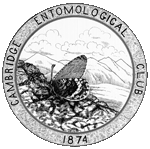
| January 2008: Psyche has a new publisher, Hindawi Publishing, and is accepting submissions |
Article beginning on page 113.
Psyche 3:113, 1880.
Full text (searchable PDF)
Durable link: http://psyche.entclub.org/3/3-113.html
The following unprocessed text is extracted from the PDF file, and is likely to be both incomplete and full of errors. Please consult the PDF file for the complete article.
PS YCBE.
from a long pairing of 5'. cmothi $ with orange-red ; tubercles on sides, blue ; head, S. gloveri '&, were the only ones thatwere yelluw. fertile. Unfortunately the larvae, reared The other crossings resulting from the
on willow and plum, all died, some reach- keeping of various species together in large - ing, like S. ceanothi, the third stage. cages, when 3 and 9 moths of the same The pairing of S. ceanotWwith S. glav- species were not obtained at the same time. eri %, was from the evening of 29 to the are the following : in a hot-house, 22 May, evening of 21 May. The larvae hatched - Telea polyphemus 9 and Attwus mylitta from 15 to 21 June ; the majority having 'S of the Bombay race ; T. polyphemus 9 hatched 16 and 17 June.
and Attaws pmyi '& ; Smia gloveri ?
First atage. Larger larvae, black ; small- and A. pemyi % : in my house at ordinary er ones, fallow; the colors becoming of a temperature, 12 and 13 June, Smia ce- more uniform hue as the larvae increased anothi 9 and S. cecropia ti ; 15 June, S. in size. Very much like S. cecroph larvae, ghv& 9 and 8. ceoro~ia S ; 18 and 19 Second stage. Larvae yellow, with black
June, S. cecropia 9 and 8. ceanothi 'å£
In
tubercles ; head black.
Third stage. Back, all the above cases, the ova were infertile. bluiah ; aides, yellow.
Tubercle8 on back,
ON AN AQUATIC SPHINX LARVA.
BY HERMAN AUGUST HAGEN, CAMBRIDGE, MASS. The following letter from the Baron vou
caterpillar. As I am familiar with all the Eeizennteio, in New Orleans, La., was eeat other known larvae of the genus Philam- to me as a scientific communication by Dr. plws, and it is not probably that of Ph. J. L. LeCoate, of Philadelphia : - fa&ntscoe, a strictly tropical species, which '' From larvae and pupae of a sphinx in 1 do not know, so it is very likely an entirely my possession, there is every reason for be- new apecies. lieving that I have made a new acquisition Of the other species of Phila,m/fietm (pe- to the lepidopterous fauna of Louisiana. culiar only to the new continent) are until They belong to the genus Phdampelṳ but now only known and described : Philam- the larvae far exceed in size those of the plus vitis Lien., Ph. achemow, Ph. satel- other known sphingidae, even of the true Uiita, Ph. fasciaha, and PA, l-ycaon Cram. sphinx Mctcrosila rustics (Sphinx chion- (posticatw Grote) , all occurring here, ex- anthi). I found the larvae feeding on the eept achernon, a northern species, and whose floating Symiphaea, in the very centre of a larvae are all known to me. draining canal in the outskirts of the city. There remains then only Philampelus
When I discovered them, their whole body, Zahruscae, which I do not believe is the with the exception of the first three segments, sphinx in question. Of 25 larvae (now all
was submerged in the water.
When they, pupae) in my possession, I preserved one had devoured one patch of the water plants, in alcohol, to have an ' urgwmentum ad they swam with great facility to a new one, horninem " for a further occasion, when I the first instance I ever experienced of this will prepare a correct drawing of the in- habit in the larva of a sphinx, or in any sect in all its stages.
================================================================================
Volume 3 table of contents